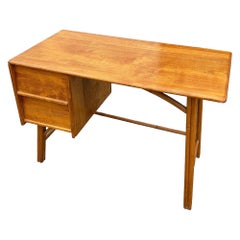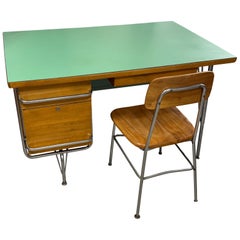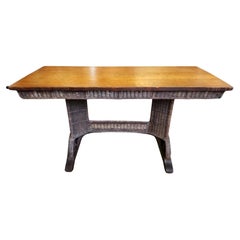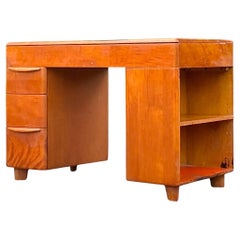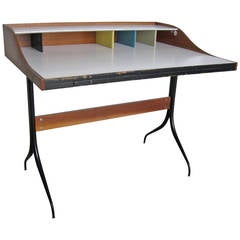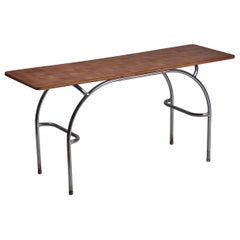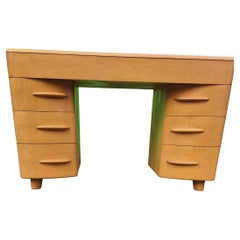Heywood-Wakefield Co. Desks and Writing Tables
Mid-century modern furniture obsessives seeking vintage Heywood-Wakefield tables shouldn’t be fooled by the harmony that the company’s hyphenated name suggests. For much of the 19th century, Heywood Brothers and Wakefield Company were bitter rivals.
Founded in 1826 and 1855, respectively, both Heywood Brothers and Wakefield Company were Massachusetts manufacturers that produced American-made furniture, specializing initially in wicker and rattan. The five Heywood brothers started their furniture business in a backyard shed, making wooden tables and chairs with cane or wicker seats, while Wakefield founder Cyrus Wakefield began working with scrap rattan, which he bought at the Boston docks, where it was used as cushioning in the holds of cargo ships. In 1897, however, the two joined forces, merging to become Heywood Brothers & Wakefield Company, which was later simplified to Heywood-Wakefield Co.
The company would eventually purchase the Washburn-Heywood Chair Company, the Oregon Chair Company and Lloyd Manufacturing Company, creating a mini-empire of American furniture with manufacturing locations across the country.
Heywood-Wakefield’s earliest solid-wood table designs reflect the decorative emphasis and Japanese influence that swept the United States at the turn of the century. In the ensuing years, the brand adopted principles of the Arts and Crafts movement, but by the 1920s, interest in wicker furniture was waning in America. To boost sales, the company enlisted guest designers like Paul Frankl, who crafted coffee tables with sturdy bamboo supports and other furnishings for the brand, and Donald Deskey, who brought his mastery of Art Deco design, with sculptural side tables boasting elegant maple tops supported by cylindrical flat-band steel bases. Gilbert Rohde introduced modern designs to Heywood-Wakefield (and also, in 1932, to Herman Miller), adding Art Deco pieces to the company’s portfolio such as sleek walnut dining tables. The company prized versatility: A set of Heywood-Wakefield’s elegant mid-century modern nesting tables are an elegant space saver in any living room, while a Rohde-designed solid-walnut console table, for example, would be fitted with hinges on its underside, so that you could position it against a wall with its top closed or, alternately, open it for serving a meal if your space was too modest to safely accommodate one of the manufacturer’s sophisticated dining tables.
No matter your needs, find an extraordinary range of vintage Heywood-Wakefield tables on 1stDibs.
1950s American Vintage Heywood-Wakefield Co. Desks and Writing Tables
Teak
1960s American Vintage Heywood-Wakefield Co. Desks and Writing Tables
Steel
Late 19th Century American Aesthetic Movement Antique Heywood-Wakefield Co. Desks and Writing Tables
Wicker, Oak
Mid-20th Century American Mid-Century Modern Heywood-Wakefield Co. Desks and Writing Tables
Wood
1950s American Vintage Heywood-Wakefield Co. Desks and Writing Tables
Metal
1930s American Machine Age Vintage Heywood-Wakefield Co. Desks and Writing Tables
Chrome
20th Century English Heywood-Wakefield Co. Desks and Writing Tables
Leather, Mahogany
2010s American Mid-Century Modern Heywood-Wakefield Co. Desks and Writing Tables
Ash, Oak, Walnut
20th Century Heywood-Wakefield Co. Desks and Writing Tables
Birch
1930s American Art Deco Vintage Heywood-Wakefield Co. Desks and Writing Tables
Plywood, Maple
Mid-20th Century French French Provincial Heywood-Wakefield Co. Desks and Writing Tables
Wood
2010s American Modern Heywood-Wakefield Co. Desks and Writing Tables
Brass
Mid-20th Century American Mid-Century Modern Heywood-Wakefield Co. Desks and Writing Tables
Maple
Mid-20th Century North American Mid-Century Modern Heywood-Wakefield Co. Desks and Writing Tables
Wood
1970s American Mid-Century Modern Vintage Heywood-Wakefield Co. Desks and Writing Tables
Wood
Mid-20th Century American Mid-Century Modern Heywood-Wakefield Co. Desks and Writing Tables
Cut Glass, Mirror, Maple
Mid-20th Century American Mid-Century Modern Heywood-Wakefield Co. Desks and Writing Tables
Maple
1950s American Mid-Century Modern Vintage Heywood-Wakefield Co. Desks and Writing Tables
Fabric, Birch
1960s American Mid-Century Modern Vintage Heywood-Wakefield Co. Desks and Writing Tables
Maple, Fabric
Mid-20th Century American Mid-Century Modern Heywood-Wakefield Co. Desks and Writing Tables
Wood
1950s American Mid-Century Modern Vintage Heywood-Wakefield Co. Desks and Writing Tables
Wood
Mid-20th Century Mid-Century Modern Heywood-Wakefield Co. Desks and Writing Tables
Formica, Walnut
Mid-20th Century American Industrial Heywood-Wakefield Co. Desks and Writing Tables
Steel
Early 20th Century American Mid-Century Modern Heywood-Wakefield Co. Desks and Writing Tables
Birch
Mid-20th Century American Mid-Century Modern Heywood-Wakefield Co. Desks and Writing Tables
Maple
1950s American Mid-Century Modern Vintage Heywood-Wakefield Co. Desks and Writing Tables
Birch
1950s American Mid-Century Modern Vintage Heywood-Wakefield Co. Desks and Writing Tables
Maple
20th Century American Mid-Century Modern Heywood-Wakefield Co. Desks and Writing Tables
Fabric, Rattan, Maple
Heywood-wakefield Co. desks and writing tables for sale on 1stDibs.
Creators Similar to Heywood-Wakefield Co.
- 1stDibs ExpertFebruary 13, 2023Heywood-Wakefield closed in 1981 when the company went bankrupt. The furniture maker is well known for their rattan and wicker furniture as well as for their blond wood casegoods made from maple and birch wood. On 1stDibs, find a selection of Heywood-Wakefield furniture.
- 1stDibs ExpertApril 5, 2022Heywood Wakefield furniture is made of solid wood, which means the best approach to cleaning it is to use a damp cloth and a small amount of mild dish soap for clean-up. Do not get the wood overly wet or it can warp or wet spots may develop. Shop a collection of Heywood Wakefield furniture from some of the world’s top sellers on 1stDibs.
- 1stDibs ExpertApril 5, 2022Heywood-Wakefield furniture is an American brand founded in 1897. The mid-century modern furniture manufacturer uses sustainable, durable Northern Yellow birch, which gives its pieces a rich yellow color. Shop a collection of Heywood-Wakefield furniture from some of the world’s top sellers on 1stDibs.
- 1stDibs ExpertFebruary 13, 2023To identify Heywood-Wakefield wicker furniture, look for the maker's mark. It will either be printed on a paper label or stamped onto the piece in an inconspicuous area like the bottom or back. Pieces made after 1949 normally have the company name positioned inside of an eagle. Earlier furnishings will likely just show the maker's name. If you're unsure whether a specific piece is authentic, a certified appraiser or experienced antique dealer can assist you. Shop a range of Heywood-Wakefield furniture on 1stDibs.
- 1stDibs ExpertSeptember 23, 2024To identify a Heywood-Wakefield chair, you can first look for a maker's mark. Beginning in 1949, the manufacturer began affixing paper labels to the undersides of chair seats. These labels usually feature the brand name along with an eagle logo. Unfortunately, the paper labels tended to come loose over time, so not all chairs will feature them, and pieces produced before 1949 are usually unmarked. If you can't find a marking, examine the hardware that holds the chair together. Heywood-Wakefield typically used Phillips head screws, so the presence of other types of fasteners will usually indicate that a different manufacturer produced the chair. In addition, the maker only utilized solid wood to construct its chairs. If you see plywood or veneers, your chair is probably not a Heywood-Wakefield. Because it can be difficult to identify an unmarked chair on your own, you may wish to have a certified appraiser or knowledgeable antique dealer assist you. Explore a range of Heywood-Wakefield chairs on 1stDibs.
- 1stDibs ExpertFebruary 1, 2024To identify Heywood-Wakefield furniture, search for the maker's mark. You will typically find it on a paper label or stamped directly onto an inconspicuous part of the piece, such as under the seat or tabletop. Early pieces usually display the company's name on its own, while those manufactured after 1949 will often have an eagle logo along with the Heywood-Wakefield wordmark. If questions about authentication remain, a certified appraiser or experienced antiques dealer can assist you. Explore a diverse assortment of Heywood-Wakefield furniture on 1stDibs.
- 1stDibs ExpertFebruary 13, 2023Heywood-Wakefield started making furniture in 1897. The company formed from the merger of two rattan furniture manufacturers, Heywood Brothers and Wakefield Company. Both companies were in Massachusetts. On 1stDibs, find a collection of Heywood-Wakefield furniture.
- 1stDibs ExpertApril 5, 2022Yes, Heywood-Wakefield uses solid wood to create its furniture. The lumber used for the designs is sustainable and harvested from farms in New Hampshire. You can shop a collection of Heywood-Wakefield furniture from some of the world’s top sellers on 1stDibs.
- 1stDibs ExpertFebruary 13, 2023Heywood-Wakefield furniture was made from a variety of woods. However, the furniture maker's acclaimed blond wood casegoods were made from birch and maple wood. On 1stDibs, find a selection of Heywood-Wakefield furniture.
